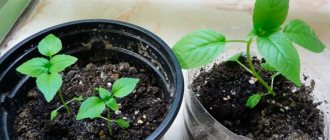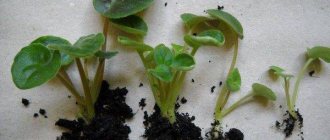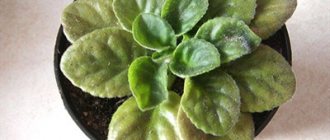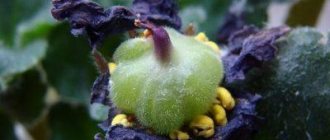Many gardeners have encountered the fact that their violets do not want to develop normally, although they are systematically watered and choose a place with suitable lighting. As a rule, upon detailed analysis of care, it turns out that they do not comply with the only condition - the correct application of fertilizers for violets (Saintpaulias).
The main mistakes may be due to the fact that universal preparations are not suitable for these flowers, since they have their own characteristics. People who use such complexes are doomed to contemplate green bushes without buds and inflorescences, and in the worst case, to watch the plants gradually wither. To apply suitable fertilizing, it is enough to know the main features of this species and apply it in practice, which is not at all difficult.
Biological features
The nutrient requirements of violets are higher than those of other plants. There are several reasons for this:
- Extended growing season . Saintpaulias have a short rest period, and during the long growing season they need a high content of active elements in the soil.
- Long flowering . For many varieties, the decorative period lasts 10-11 months, which is very costly in terms of nutritional resources. For them, a constant supply of resources along with watering is critical.
- Small volume of substrate . For normal development of Saintpaulia, the root system needs to be crowded, otherwise it will stop budding and begin to hurt. In a small volume of land, food runs out even faster, so its reserves must be constantly replenished.
In addition, it is important to know that fertilizing for violets in a diluted state should have a slightly acidic pH reaction. Universal fertilizers for flowering crops do not give this effect, so their use is not recommended.
Conditions for flowering
In order for violets to bloom for a long time, a number of conditions must be met. Flowers love good light, but on the sunny side their foliage burns . In this case you can:
- close the windows with light curtains or blinds;
- place them on shelves using artificial lighting.
When watering with a concentrated liquid preparation, it should be diluted in settled water for irrigation according to the instructions. It is advisable to alternate mineral and organic fertilizers.
According to the advice of experienced gardeners, foliar feeding of violets should be done in warm (20-23 degrees) and dark times of the day.
In addition , violets do not bloom if:
- old soil in the pot;
- if they grew old, the root came out and the leaves were crushed;
- the pot is too crowded and there is not enough nutrition.
Necessary substances
Throughout the year, violets need different elements, which are contained in complex flower fertilizers. The main ones:
- Nitrogen . The most important substance that is necessary for the construction of new cells. Without it, the growth of green mass does not occur, so for young bushes until the buds appear, nitrogen is the most important. When the decorative period begins, the need for it decreases, but does not completely disappear.
- Potassium and phosphorus . They ensure the formation of flowers, the number of buds on the bush, the brightness of the color and the duration of flowering. In addition, phosphorus and potassium allow the root system to remain healthy and active, making it easier to endure stress and unfavorable periods.
- Humates . The chemical basis of humus as a source of organic matter. They are needed for the continuous flow of all vital functions, accelerate cell division, increase immunity against infections and fungi, and also regulate water balance.
- Microelements . Violets need sulfur, calcium, magnesium, boron, iron, manganese, zinc, molybdenum and copper throughout the year, but in minimal quantities. Each of these substances makes the plant stronger and more luxuriant. Without microelements, the bush will not die, but its decorative properties will be greatly reduced if there is a deficiency.
When choosing fertilizers, you should pay attention to the presence of all these substances in the composition.
Methods and rules for applying fertilizing
It is better to give violets less fertilizer than more. However, this also applies to other cultures.
Application of fertilizing during wick irrigation
General rules for feeding Saintpaulia:
- the water should be soft, room temperature or a few degrees higher;
- Fertilizers are applied only on a damp substrate, otherwise chemical burns of the root are possible;
- powdered preparations or crystals must first be dissolved in water, then drained from the sediment;
- you cannot feed a sick or pest-infested violet - this is additional stress;
- At least 2 weeks must pass after the transplant;
- It is recommended to strictly adhere to the dosage; if this is not possible, you need to prepare a working solution with a obviously smaller amount of the drug;
- In summer it is better to feed the bush in the evening, in winter - in the morning.
If Saintpaulia is generally healthy and develops well, but is in no hurry to bloom, you need to additionally give phosphorus fertilizers 1-2 times.
Root
The drug is dissolved in water at room temperature and drained from the sediment. Carefully lift the violet leaves and pour along the edge of the pot from all sides until the liquid begins to flow into the pan. After 20-30 minutes, remove excess water.
It is impossible for the working solution to get on the leaves, especially in the center of the rosette. In summer, this can lead to sun or thermal burn; in winter, it contributes to the rotting of vegetative organs. In any case, unsightly spots will remain on the pubescent plates.
To pallet
Thus, it will not be possible to feed Saintpaulia correctly. Fertilizer must be applied to a damp substrate, which means that the water has already saturated the earthen lump, and it will rise upward slowly.
Most of the preparation will remain in the pan, and the owners think that they have already fed the violet. If you leave the working solution for a long time, this can lead to acidification of the substrate and damage to the root.
With wick watering
It’s simple – add the required dose of the drug to the water and pour it into the lower container. Dip the cord into the liquid. When the violet needs to rest (1 week out of 4), the stand container is rinsed and filled with clean water.
Foliar
A quick method, it works almost immediately, but is extremely undesirable for Saintpaulia. She generally doesn’t like it when leaves are sprayed:
- whitish spots will definitely remain, which can only be washed off with clean water;
- drops of liquid are retained between the hairs and can turn into lenses and cause burns or cause rotting.
You can feed Saintpaulia leaf by leaf only if there is no other option:
- there is an imbalance of nutrients, the situation needs to be corrected urgently;
- root doesn't work;
- Immediately after an illness, the plant sometimes cannot absorb fertilizers in a different way.
If the flower is healthy and regularly receives nutrition at the root, there is no need to fertilize violets leaf by leaf.
Signs of Deficiency
Nutritional deficiencies can be judged by a general decline in growth or lack of nutrition. But experts will recognize an acute deficiency of individual micro- or macroelements by certain signs:
- Nitrogen - crushing of leaf blades, shoots and old leaves from bright green become light green or yellow. At the last stage, the edges of the leaves curl up, a black border appears, and they fall off.
- Phosphorus - delayed flowering, purple tint of foliage. Symptoms are first visible on old leaves and then appear on new ones.
- Potassium - dead dark spots become noticeable on the leaf blades, the edges darken and wrinkle. The plant becomes susceptible to various diseases.
- Sulfur - Deficiency symptoms are similar to nitrogen deficiency, but leaf fall does not occur.
- Calcium - young shoots become dark green in color, and the root system becomes covered with mucus.
- Magnesium - discoloration of leaf blades and veins, yellow stripes may appear.
- Iron - yellowness of young foliage, without spots, uniform color change.
- Boron - a sharp slowdown in growth and a decrease in resistance to viruses, bacteria and fungi.
When applying fertilizers in a complex manner, there is no need to track the individual intake of each element, so this option is considered the most successful.
How to understand that a violet needs feeding
The need to fertilize is noticeable primarily by the appearance of the flower.
- Weak and lethargic violets require urgent intervention.
- Changing the color of the leaf blade, wilting or even falling off is another reason for urgent adjustments to the plant’s nutritional regimen.
- The lack of buds and flowers is the result of a lack of minerals.
Floral variety
When not to fertilize
Excess nutrition is just as harmful as deficiency. Therefore, it is important for flower growers to know in what situations Saintpaulias do not need fertilizer:
- For two months after transplantation. During this period, the plant has enough of the substances that are in the fresh substrate. In addition, after transplantation, the roots are injured; their suction hairs must be stabilized before they can absorb solutions with minerals.
- At temperatures above or below normal. Both cases force the plant to suspend its development, and if it continues to initiate growth, it can cause deformation of the shoots and disruption of physiological processes.
- Unhealthy specimens. If any signs of disease are detected, fertilizing is stopped immediately and the normal regime is restored only after the plant has fully recovered.
In all these situations, adding nutrient solutions will cause the violet to deteriorate.
Do I need to feed violets after transplanting?
How to feed violets after transplantation and is it necessary to do so? It is not recommended to feed the flower with fertilizers immediately after a stressful procedure.
After 2-3 weeks it is necessary to carry out the first feeding. Before carrying out it, it is necessary to carefully examine the Saintpaulia. Feeding the flower is allowed only if it looks “healthy”. If the violet has a sluggish and drooping appearance, this may be the result of improper care or damage by harmful insects.
Important! Diseases that occur during the period of active growth do not allow the application of fertilizing until the species has completely recovered.
Forms of drugs
Complex fertilizers for Saintpaulias are produced in the following forms:
- liquid;
- powdery;
- in the form of granules or sticks.
Experts recommend choosing liquid medications. They are easier to dose when it comes to indoor growing, and at the same time they are safer to use. This is due to the fact that they are easier to mix and average the concentration compared to crystals. That is, the risk of root burn is much less.
In dry form, the cooking time increases, and dissolution may not be complete. In this case, it is advisable to prepare the solutions in advance so that they have time to average out, but before watering, the liquid is still mixed well.
Powdered drugs dissolve better than crystals.
Granules and sticks provide a prolonged effect. The granules are mixed with the soil at the time of transplantation or they are scattered on the surface, after which the soil is loosened so that they get deeper. The sticks are simply inserted deeper into the ground. But such forms are not the best option for Saintpaulias, since granules or sticks in direct contact with the roots can cause them to burn. But on the other hand, this minimizes plant care, since you don’t have to prepare a nutrient solution every week or two.
What you need to know about planting and transplanting
Given the characteristics of the natural habitats of Saintpaulias, it is not difficult for them to imitate the natural environment.
How to make a soil mixture
In mountainous areas, the soils are not fertile. At home, the nutrient substrate is usually prepared on the basis of ready-made peat soil. Here are a few options recommended by amateur flower growers and famous breeders:
| Author | Compound |
| A popular recipe often found in literature | 4 liters of peat soil, 1-2 liters of nutrient soil, 3 tablespoons of crushed charcoal, 3 cups of perlite or vermiculite, 3 cups of chopped sphagnum |
| E. V. Korshunova | A bucket of peat soil (“Agrobalt”), a quarter of perlite, a glass of dry mullein |
| B. M. and T. N. Makuni | 1 part leaf humus, 3 parts high peat, 1 part chernozem or nutrient soil, 1 part river sand or vermiculite, 1 part sphagnum |
It is clear that not all components can be obtained year-round. At first, it is worth using ready-made soil for violets, and in the summer, stock up on humus, mullein, and collect sphagnum from the forest.
Specialized soil is offered by various domestic and foreign manufacturers
Before planting, some gardeners disinfect the soil in the oven or microwave, but such steaming can lead to the death of beneficial bacteria, nitrogen volatilization, the formation of salts, and slow down the development of the plant. It is better to treat with “Fitosporin”, which will protect against possible fungal and bacterial diseases.
Pot size matters
The main rule when growing violets: do not take large pots. The plant will be delighted with the space and will actively grow leaves, completely forgetting about the flower stalks!
Large rosettes are planted in pots with a diameter of 8-10 cm; for small and mini varieties, 5-6 cm are useful. Plastic containers are better. Especially if you got a violet, were captivated by its beauty, bought more, and then wanted to grow it yourself from a leaf cutting... - you will need a lot of pots! Plastic ones are not as expensive compared to ceramic ones.
It is imperative to provide a drainage layer that occupies one third of the volume of the pot.
It is important that there are drainage holes at the bottom of the containers, otherwise you will have to make them yourself
It will not be possible to fully care for a flower without regular transplants, which are carried out 1-2 times a year. Due to the small volume, the soil is depleted after 2 months. To quickly form a beautiful symmetrical rosette and lush flowering, regular feeding is required.
Complex drugs
All complex preparations indicate the NPK formula, that is, the ratio of nitrogen, phosphorus and potassium. In addition, the instructions for the fertilizer for violets should contain information about other components - microelements, amino acids, vitamins and humates. At different stages, the plant needs different ratios of the NPK complex:
- High nitrogen content . It is used for rosettes, planted children and young bushes before bud formation begins.
- Focus on phosphorus . Suitable for specimens at the stage of flower formation, as it stimulates the growth of buds in adult Saintpaulias and produces abundant flowering in the future.
- Increased amount of potassium . Causes bright coloring of petals and resistance to lack of lighting. Prevents sealing of the middle part of the socket.
It is recommended to choose a complex taking into account the physiological stage.
The best fertilizers for violets are:
- "Fasco". This is a professional specialized product with an ideal balanced formula. It not only gives the plant everything it needs, but also improves the soil structure. The instructions for use say that the Fasco fertilizer contains all substances in a chelated, easily accessible form, so its use very quickly improves the appearance of violets.
- "Mr. Color" It is convenient that the liquid concentrate is dosed into a small volume of water, so those who have a little Saintpaulia can use the drug. Can be used in soil and hydroponics.
- "Stimovit." Organo-mineral complex, suitable for fertilizing and soaking before transplanting. Acts as a root former and growth activator.
- "Good Power" In addition to the standard set of substances, it contains succinic acid. It accelerates the absorption of nutrients from the soil, activates photosynthesis, etc.
- "Bona Forte". A solution that contains everything necessary for good vegetation and flowering of violets. The bottle is equipped with a dispenser cap, which is very convenient for preparing the required volume.
All of them moderately acidify the soil, and Saintpaulias need this for the normal development of the root system.
How to water homemade violets to bloom profusely
How to feed fuchsia for abundant flowering
Fertilizers can be intended for root feeding or for spraying Saintpaulia. The use of certain drugs must be due to compelling reasons. To fertilize violets, it is recommended to use either ready-made preparations or self-prepared ones using natural ingredients.
Proper watering of the plant
Ready-made complex fertilizers
The use of ready-made preparations significantly reduces the time and facilitates the process of fertilizing.
Unlike folk remedies, they do not need to be prepared in advance and concentration must be maintained. For violets it is recommended to use the following:
- Peters (Peters Professional). After using this product, the condition of the root system and violet leaves improves. It is recommended to use at the first signs of calcium deficiency. Application in winter promotes better budding in the future.
- Etisso. The product is enriched with vitamin B and beneficial microelements. Helps improve budding and increase the number of inflorescences.
- The universal fertilizer Fusco helps improve the appearance of the flower. The use of this drug allows you to increase the flowering time of violets at home.
- The drug Fort is used not only for violets, but also for begonias. It helps restore the soil and maintain the health of the flower. The manufacturer recommends weekly feeding from spring to autumn, and monthly in the autumn-winter period.
On a note. Complex fertilizers are considered more productive and effective than folk remedies.
Another interesting question is how to feed violets to stimulate them during the breeding season? Experts recommend using cytokinin paste for these purposes. If an artificially scratched plant stem is treated with this product, in 10-12 days children will grow on the flower.
Mineral nutrition for violets
Organic
The violet should be fed consistently, alternating organic and mineral preparations. Saintpaulia loves any organic matter very much. The selection of necessary fertilizers should be carried out as carefully as possible. Experienced flower growers advise using:
- Manure, bird droppings. It is preferable to use dry preparations.
- Vermicompost, concentrated or dry.
- Preparations containing microbiological components.
- Special organic substances intended specifically for violets.
Home Remedies
Not all flower growers buy fertilizers for violets; there are staunch adherents of home remedies. If you use them correctly, you can really achieve good results.
Tea
Take used brewed black tea without flavorings. One part of the tea is mixed with three volumes of soil and this substrate is used when replanting. Such soil always has enough organic matter, it does not dry out and remains loose and light. The appearance and decorativeness of the bush only improve over time.
Coffee
For this you need spent and dried grounds. You can simply pour it into a pot on top of the soil, or you can mix it with the substrate during transplantation. The result will be similar to adding tea leaves, so even with infrequent watering, the risk of drying out is reduced, which makes caring for the plant easier.
Citrus
The zest or peel of citrus fruits is used. Their use increases resistance to fungi and bacteria. This is achieved thanks to citrus essential oils, since pests and parasites really dislike them.
The peel of orange, tangerine, kumquat, muraya, grapefruit, pomelo, etc. is suitable. You need to prepare it like this: wash the fruit, peel it, and pour boiling water over the skin. Let this infusion stand for a day, then strain the liquid through cheesecloth. Before use, dilute with warm water in a ratio of 1:10.
Onion
This vegetable not only helps Saintpaulia get nutrients, but also prevents many diseases. They use husks that are well boiled. After this, the liquid is cooled and used. This solution cannot be stored, as it deteriorates within a day or two even in the refrigerator.
Live yeast
These microorganisms have a positive effect on the condition of violets, accelerate their development and increase resistance to infections. The preparation method is as follows: 1 teaspoon of dry yeast is mixed with 2 tablespoons of sugar and dissolved in 5 liters of water. Place this preparation in a warm place for 4 hours. Then it is diluted with clean water in a ratio of 1:5.
Sugar
To prepare the solution, 1 tablespoon of sugar is diluted in a liter of water. It must be used immediately; it should not be stored for more than a few hours. This feeding is carried out once a month.
Briefly about the features of keeping violets
Perhaps you know what rules must be followed when planting violets at home.
But even if so, repetition is the mother of learning, so let’s list the features of keeping Saintpaulia at home again. Capacity. In order to grow and bloom normally, the violet pot must have a diameter of 13 cm.
Substrate. The soil in which you plant a houseplant must be well aerated and light enough
It is important that the substrate has the ability to retain moisture.
Content temperature. The minimum temperature standard for growing Saintpaulias is 20 degrees Celsius. Maximum - 25 degrees.
Regularity of watering. It is important not to overfill or overfill the violet.
Don’t let the flower go without water for too long, but you shouldn’t add water to the still-damp soil either.
Winter care. During the cold season, violets are sorely lacking sunlight. Therefore, it is important to illuminate Saintpaulias with special lamps. If you don’t have them on your household, regular solar lamps will do.
Another point of caring for Saintpaulias is feeding. We will talk about it in more detail below.
But let’s make a reservation right away: it’s not enough to just fertilize violets, it’s important to do it in a timely manner. Because, for example, in the cold season, microelements added to the soil will only interfere with Saintpaulia
And this is not the only feature of adding nutrients to the soil.
Frequency and timing
This detailed fertilization scheme promotes long flowering and a very short dormancy period:
- late February-early March - once every 2 weeks; if there was a transplant, then stop feeding until April;
- April-May - once every 9-10 days;
- summer - once a week;
- September - once every 10 days;
- October - every 2 weeks;
- November - once every 2 weeks with a concentration 2 times less than that indicated in the instructions.
From December to February, fertilization is stopped, since violets are less active at this time.
Mineral fertilizers for feeding indoor violets
Mineral fertilizers are popular for watering violets.
- "Bona forte". An ideal fertilizer to feed violets so that they bloom. It stimulates not only flowering, but also growth. The composition includes various microelements in easily digestible chelate form. Contains nitrogen and phosphorus in equal proportions. Nitrogen helps violets grow green mass, and phosphorus increases immunity to disease. The resulting solution can be stored for up to two weeks. Fertilizing in liquid form at the root. It is recommended to alternate with other types of fertilizing every 3-4 months.
| On a note. For 1.5 liters you need to add 10 ml of the substance. |
- "Ideal". A universal concentrated product based on vermicompost, containing a large range of microelements. Liquid fertilizer. Promotes uniform development of violets. You can feed both at the root and at the leaf. It is advisable to alternate them so that the above-ground and underground parts of the violet develop evenly. Apply fertilizer at intervals of 1-2 weeks. For foliar feeding, 4–5 ml of fertilizer is taken per 1 liter of water. It is recommended to spray once every 7–10 days. To water at the root, you need to take 8–10 ml of the substance per 1 liter of water.
- "FASCO Flower Happiness." Liquid complex fertilizer. The composition includes a set of essential microelements that the plant needs for active growth. After applying this fertilizer, violets begin to develop harmoniously, bloom luxuriantly and actively. Watering at the roots or spraying on the leaves. Before use, be sure to read the instructions carefully. Take 10 ml of the substance per liter of water - this is for irrigation. To spray 2 liters of liquid you need 10 ml of fertilizer.
Photo pexels/Anna: You can spray on the leaves.
How to fertilize
There are three types of fertilization for Saintpaulias:
- at the root;
- bottom watering (into a tray);
- by sheet.
Before adding to the soil, the flower needs to be watered a day or two. As a rule, bottom watering through a tray is preferable because in this way minerals do not crystallize along the surface of the ground.
To spray the drug on a leaf, you need to have skill and choose the right time. This should not be done when the violets are in bloom, as the solution will leave stains on the petals after drying. In addition, drops can linger in the leaf fibers, which is also undesirable.
Feeding calendar
When budding or active growth of violets begins, it is time to fertilize. It is necessary to feed violets in summer and spring. From September it is better to stop adding fertilizers, since after flowering the plant’s growth subsides and it does not need extra loads. Fertilizing violets is a simple procedure; it will only bring benefits to Saintpaulia.
It should be borne in mind that there is a moment when applying fertilizers can greatly harm home beauties:
- After transplantation, when the plant adapts to the new container, it is sufficiently weakened and it is better not to apply fertilizer.
- If the soil is too dry, it needs to be watered before fertilizing. Otherwise, the fertilizer may burn the roots.
- When the room temperature is too low or high.
- When the leaves are exposed to direct sunlight.
You may be interested in: Feeding hydrangeas in the fall for beautiful flowering
You should not feed the plant when replanting. It is necessary to select soil rich in nutrients. If the violet was purchased in a store, you need to give it time to acclimatize in new conditions (about 2 weeks). There is no need to try to feed the plant at this time.
In spring, it is best to apply nitrogen fertilizers. Nitrogen is useful for increasing vegetative mass. As soon as the buds appear, you need to eliminate nitrogen fertilizers. For rapid flowering, it is better to feed Saintpaulia with phosphorus and potassium. Feeding is carried out once every two weeks in the following ways:
- The liquid fertilizer solution is added to the pan.
- Introduce at the root so that the fertilizer does not get on the leaves.
Nutrient requirements of violets
The main elements are: nitrogen (N), phosphorus (P), potassium (K). Nitrogen is needed for plant growth, giving leaves a rich green color. If there is an excess of nitrogen, you will not see flowering. Phosphorus enhances root development and promotes budding; if it is deficient, violets also do not bloom. Potassium also promotes flowering and increases resistance to disease.
In small quantities , sulfur, magnesium (for growth, formation of chlorophyll), calcium (strengthens plant tissues, strength of flower stalks), iron, a complex of trace elements (manganese, boron, zinc, copper, cobalt, silicon) are needed.











